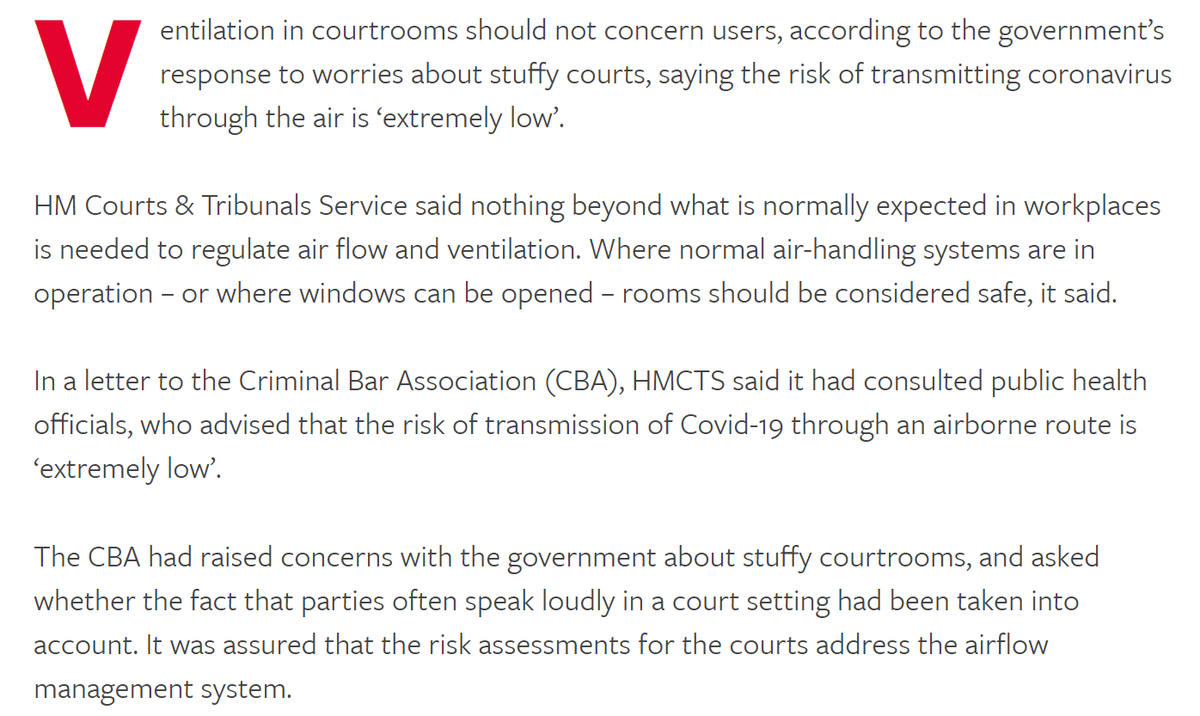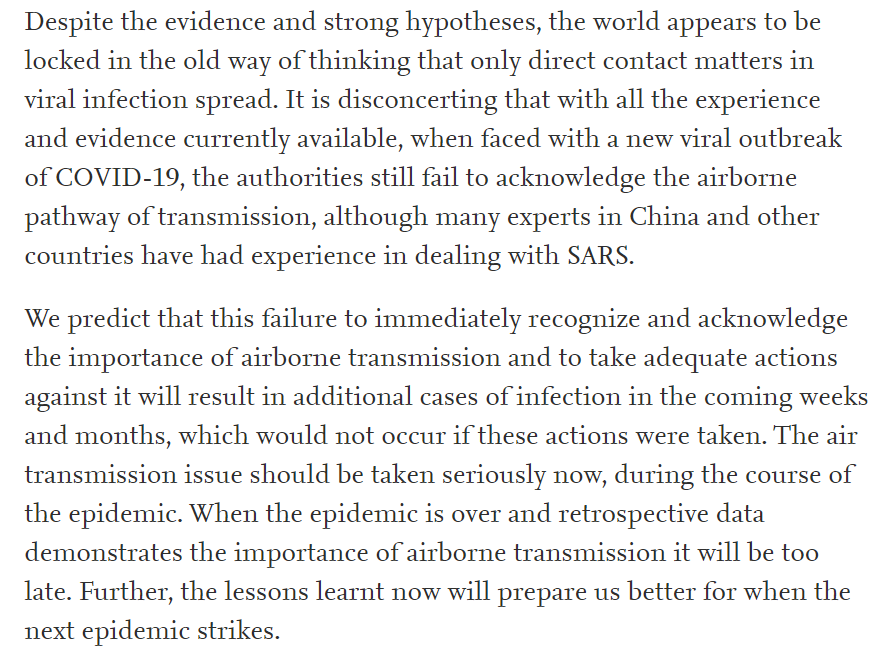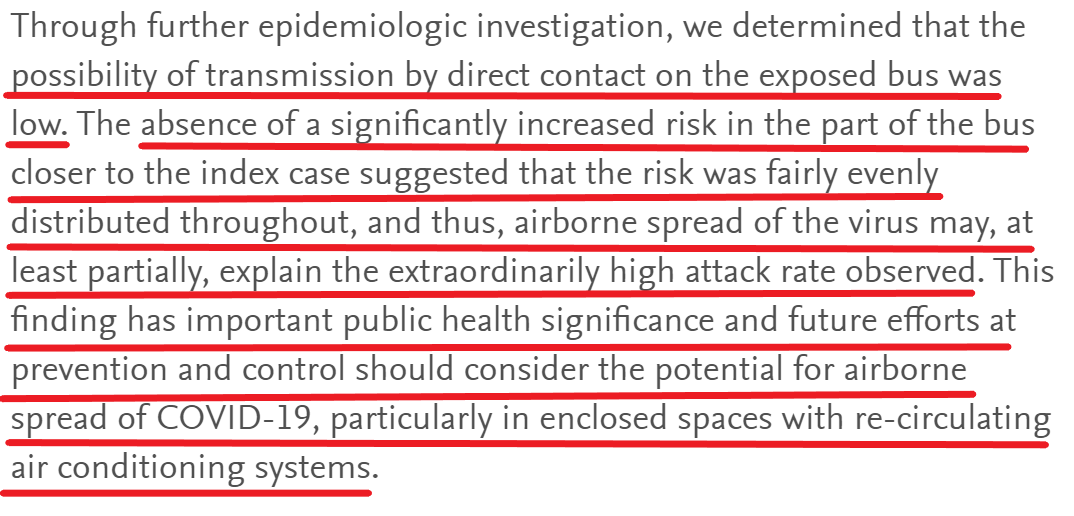The UK government's response to concerns regarding airborne Covid-19 transmission in courtrooms is alarming . It indicates that they're ignoring an increasing body of evidence of such transmission. 1/10
. It indicates that they're ignoring an increasing body of evidence of such transmission. 1/10
https://www.lawgazette.co.uk/news/dont-worry-about-stuffy-courts-says-hmcts/5104400.article
 . It indicates that they're ignoring an increasing body of evidence of such transmission. 1/10
. It indicates that they're ignoring an increasing body of evidence of such transmission. 1/10https://www.lawgazette.co.uk/news/dont-worry-about-stuffy-courts-says-hmcts/5104400.article
On 26 May, the UK government released a SAGE paper addressing airborne transmission (link ). The paper itself is dated 28 April and based on research up to 26 April. Key excerpt
). The paper itself is dated 28 April and based on research up to 26 April. Key excerpt . 2/10
. 2/10
https://gov.uk/government/publications/environmental-influence-on-transmission-of-covid-19-28-april-2020
 ). The paper itself is dated 28 April and based on research up to 26 April. Key excerpt
). The paper itself is dated 28 April and based on research up to 26 April. Key excerpt . 2/10
. 2/10https://gov.uk/government/publications/environmental-influence-on-transmission-of-covid-19-28-april-2020
Note that, unlike the government's letter to the CBA (see 1/10 ), this does NOT say that risk of airborne transmission is "extremely low". Rather, it says "Evidence for airborne transmission is limited and hard to get, and there is little quantitative data available". 3/10
), this does NOT say that risk of airborne transmission is "extremely low". Rather, it says "Evidence for airborne transmission is limited and hard to get, and there is little quantitative data available". 3/10
 ), this does NOT say that risk of airborne transmission is "extremely low". Rather, it says "Evidence for airborne transmission is limited and hard to get, and there is little quantitative data available". 3/10
), this does NOT say that risk of airborne transmission is "extremely low". Rather, it says "Evidence for airborne transmission is limited and hard to get, and there is little quantitative data available". 3/10
The SAGE paper mentions the Chinese restaurant case study which @erinbromage also discusses in his widely read blog post . But various other case studies indicating airborne transmission go unmentioned. 4/10 https://www.erinbromage.com/post/the-risks-know-them-avoid-them
. But various other case studies indicating airborne transmission go unmentioned. 4/10 https://www.erinbromage.com/post/the-risks-know-them-avoid-them
 . But various other case studies indicating airborne transmission go unmentioned. 4/10 https://www.erinbromage.com/post/the-risks-know-them-avoid-them
. But various other case studies indicating airborne transmission go unmentioned. 4/10 https://www.erinbromage.com/post/the-risks-know-them-avoid-them
There are a number of recent publications in scientific journals which state much stronger cases for airborne Covid-19 transmission than is indicated in either the SAGE paper or UK government guidance. 5/10
For example, this paper , published in Science on 27 May, DIRECTLY contradicts the UK government's claim (see 1/10
, published in Science on 27 May, DIRECTLY contradicts the UK government's claim (see 1/10 ) of "extremely low risk" of airborne Covid-19 transmission. 6/10
) of "extremely low risk" of airborne Covid-19 transmission. 6/10
https://science.sciencemag.org/content/early/2020/05/27/science.abc6197
 , published in Science on 27 May, DIRECTLY contradicts the UK government's claim (see 1/10
, published in Science on 27 May, DIRECTLY contradicts the UK government's claim (see 1/10 ) of "extremely low risk" of airborne Covid-19 transmission. 6/10
) of "extremely low risk" of airborne Covid-19 transmission. 6/10https://science.sciencemag.org/content/early/2020/05/27/science.abc6197
This paper also says there is increasing evidence that the 2 metre rule is insufficient in many indoor settings with poor ventilation. 7/10
2m social distancing is insufficient in such settings in which people spend more than brief periods of time. Properly fitted masks are also essential. 8/10
See also this new study, along very similar lines, which indicates that poor ventilation significantly increases risk of Covid-19 infection in small rooms and points to the need for high-performance face masks to prevent infection. 9/10 https://www.thelancet.com/journals/lancet/article/PIIS2213-2600(20)30245-9/fulltext
Finally, see this paper , which expresses deep concern over the "failure" of governments to "acknowledge the importance of airborne transmission and to take adequate actions against it"
, which expresses deep concern over the "failure" of governments to "acknowledge the importance of airborne transmission and to take adequate actions against it" . 10/10
. 10/10
https://www.sciencedirect.com/science/article/pii/S016041202031254X
 , which expresses deep concern over the "failure" of governments to "acknowledge the importance of airborne transmission and to take adequate actions against it"
, which expresses deep concern over the "failure" of governments to "acknowledge the importance of airborne transmission and to take adequate actions against it" . 10/10
. 10/10https://www.sciencedirect.com/science/article/pii/S016041202031254X
18 May SAGE paper on Public Transport (link ), based on evidence up to 16 May, says "uncertainties over the generation of virus-containing small aerosol and infectious dose make it difficult to quantify the importance of airborne transmission"
), based on evidence up to 16 May, says "uncertainties over the generation of virus-containing small aerosol and infectious dose make it difficult to quantify the importance of airborne transmission" . 1/
. 1/
https://assets.publishing.service.gov.uk/government/uploads/system/uploads/attachment_data/file/888755/4b._EMG-Transport_Overview_18502020-updated_S0407.pdf
 ), based on evidence up to 16 May, says "uncertainties over the generation of virus-containing small aerosol and infectious dose make it difficult to quantify the importance of airborne transmission"
), based on evidence up to 16 May, says "uncertainties over the generation of virus-containing small aerosol and infectious dose make it difficult to quantify the importance of airborne transmission" . 1/
. 1/https://assets.publishing.service.gov.uk/government/uploads/system/uploads/attachment_data/file/888755/4b._EMG-Transport_Overview_18502020-updated_S0407.pdf
Again, unlike govt's letter to CBA (see 1/10 ), this does NOT say that risk of airborne transmission is "extremely low". Rather it speaks of uncertainties re likelihood of this means of transmission. Govt assertion of "extremely low" risk therefore appears ungrounded. 2/2
), this does NOT say that risk of airborne transmission is "extremely low". Rather it speaks of uncertainties re likelihood of this means of transmission. Govt assertion of "extremely low" risk therefore appears ungrounded. 2/2
 ), this does NOT say that risk of airborne transmission is "extremely low". Rather it speaks of uncertainties re likelihood of this means of transmission. Govt assertion of "extremely low" risk therefore appears ungrounded. 2/2
), this does NOT say that risk of airborne transmission is "extremely low". Rather it speaks of uncertainties re likelihood of this means of transmission. Govt assertion of "extremely low" risk therefore appears ungrounded. 2/2
For fairly good evidence of airborne transmission beyond 2 metres, see this analysis of a case study involving an asymptomatic woman who infected 23 of 67 passengers who spent 100 minutes riding the same bus.
of a case study involving an asymptomatic woman who infected 23 of 67 passengers who spent 100 minutes riding the same bus.
https://papers.ssrn.com/sol3/papers.cfm?abstract_id=3567505
 of a case study involving an asymptomatic woman who infected 23 of 67 passengers who spent 100 minutes riding the same bus.
of a case study involving an asymptomatic woman who infected 23 of 67 passengers who spent 100 minutes riding the same bus.https://papers.ssrn.com/sol3/papers.cfm?abstract_id=3567505
New Journal of Am Medical Assn article on airborne Covid-19 transmission by two Harvard Medical School professors who are experts on airborne infectious respiratory diseases. They maintain that "an airborne component of transmission is likely"
on airborne Covid-19 transmission by two Harvard Medical School professors who are experts on airborne infectious respiratory diseases. They maintain that "an airborne component of transmission is likely" . 1/
. 1/
https://jamanetwork.com/journals/jama/fullarticle/2766821
 on airborne Covid-19 transmission by two Harvard Medical School professors who are experts on airborne infectious respiratory diseases. They maintain that "an airborne component of transmission is likely"
on airborne Covid-19 transmission by two Harvard Medical School professors who are experts on airborne infectious respiratory diseases. They maintain that "an airborne component of transmission is likely" . 1/
. 1/https://jamanetwork.com/journals/jama/fullarticle/2766821
They also maintain that "the extent of spread associated with singing as a possible source of enhanced aerosolization makes airborne spread highly suspect" in the (much discussed) Washington State choir case  . 2/2
. 2/2
 . 2/2
. 2/2
. @ChristoPhraser, a professor of pathogen dynamics at @UniofOxford, on the implication of aerosol transmission in superspreader events .
.
https://www.sciencemag.org/news/2020/05/why-do-some-covid-19-patients-infect-many-others-whereas-most-don-t-spread-virus-all
 .
.https://www.sciencemag.org/news/2020/05/why-do-some-covid-19-patients-infect-many-others-whereas-most-don-t-spread-virus-all
Joseph Allen, Harvard School of Public Health asst prof of exposure & assessment science, points to early evidence of airborne Covid-19 transmission . 1/
. 1/
https://www.washingtonpost.com/opinions/2020/05/26/key-stopping-covid-19-addressing-airborne-transmission/
 . 1/
. 1/https://www.washingtonpost.com/opinions/2020/05/26/key-stopping-covid-19-addressing-airborne-transmission/
In linked piece called 'We cannot keep ignoring the possibility of airborne transmission', he spells out more recent accumulation of evidence
linked piece called 'We cannot keep ignoring the possibility of airborne transmission', he spells out more recent accumulation of evidence . 2/
. 2/
 linked piece called 'We cannot keep ignoring the possibility of airborne transmission', he spells out more recent accumulation of evidence
linked piece called 'We cannot keep ignoring the possibility of airborne transmission', he spells out more recent accumulation of evidence . 2/
. 2/
In addition to face masks (which he has endorsed in another article ), he proposes the following measures to control the risk of airborne transmission indoors.
), he proposes the following measures to control the risk of airborne transmission indoors. 3/3
3/3
https://www.washingtonpost.com/opinions/2020/04/02/not-all-heroes-wear-capes-many-wear-masks-you-should-too/
 ), he proposes the following measures to control the risk of airborne transmission indoors.
), he proposes the following measures to control the risk of airborne transmission indoors. 3/3
3/3https://www.washingtonpost.com/opinions/2020/04/02/not-all-heroes-wear-capes-many-wear-masks-you-should-too/
 The European Centre for Disease Prevention & Control (ECDC) now acknowledges
The European Centre for Disease Prevention & Control (ECDC) now acknowledges that "an increasing number of outbreak reports implicate the role of aerosols in COVID-19 outbreaks". 1/
that "an increasing number of outbreak reports implicate the role of aerosols in COVID-19 outbreaks". 1/https://www.ecdc.europa.eu/en/publications-data/heating-ventilation-air-conditioning-systems-covid-19
In discussion of choir & call centre case studies that @erinbromage also discusses, ECDC draws attention (as does @erinbromage) to significance of length of time of exposure to likelihood of infection . 2/
. 2/
 . 2/
. 2/
In discussion of bus case I mention , ECDC notes that proximity to a window appears to have made a significant difference
, ECDC notes that proximity to a window appears to have made a significant difference , but distance from infected person was otherwise irrelevant, suggesting that airflow & lack of ventilation played a significant role in transmission. 3/3
, but distance from infected person was otherwise irrelevant, suggesting that airflow & lack of ventilation played a significant role in transmission. 3/3
 , ECDC notes that proximity to a window appears to have made a significant difference
, ECDC notes that proximity to a window appears to have made a significant difference , but distance from infected person was otherwise irrelevant, suggesting that airflow & lack of ventilation played a significant role in transmission. 3/3
, but distance from infected person was otherwise irrelevant, suggesting that airflow & lack of ventilation played a significant role in transmission. 3/3
Excellent long-read article sheds light on earlier resistance to, and gradual acceptance of, aerosol transmission. The WHO was & is an obstacle to such acceptance. https://twitter.com/linseymarr/status/1278799622975008768
sheds light on earlier resistance to, and gradual acceptance of, aerosol transmission. The WHO was & is an obstacle to such acceptance. https://twitter.com/linseymarr/status/1278799622975008768
 sheds light on earlier resistance to, and gradual acceptance of, aerosol transmission. The WHO was & is an obstacle to such acceptance. https://twitter.com/linseymarr/status/1278799622975008768
sheds light on earlier resistance to, and gradual acceptance of, aerosol transmission. The WHO was & is an obstacle to such acceptance. https://twitter.com/linseymarr/status/1278799622975008768
Article about an open letter signed by 239 scientists who maintain that the WHO is failing to recognise the significance of aerosol transmission. https://www.latimes.com/world-nation/story/2020-07-04/coronavirus-airborne-spread
NYT article notes the costly implications of the view that there's significant airborne Covid-19 transmission, which is gaining increasing support among scientists .
.
https://www.nytimes.com/2020/07/04/health/239-experts-with-1-big-claim-the-coronavirus-is-airborne.html
 .
.https://www.nytimes.com/2020/07/04/health/239-experts-with-1-big-claim-the-coronavirus-is-airborne.html
The paper mentioned above, which was signed by 239 scientists, has now been published . https://academic.oup.com/cid/article/doi/10.1093/cid/ciaa939/5867798#.XwM3aMoaQ6w.twitter
. https://academic.oup.com/cid/article/doi/10.1093/cid/ciaa939/5867798#.XwM3aMoaQ6w.twitter
 . https://academic.oup.com/cid/article/doi/10.1093/cid/ciaa939/5867798#.XwM3aMoaQ6w.twitter
. https://academic.oup.com/cid/article/doi/10.1093/cid/ciaa939/5867798#.XwM3aMoaQ6w.twitter
Nature has just published an article about the piece signed by the 239 scientists . 1/
. 1/
https://www.nature.com/articles/d41586-020-02058-1
 . 1/
. 1/https://www.nature.com/articles/d41586-020-02058-1
And here's a thread by @jljcolorado , one of the 239, with informative rebuttals of various points made by the aerosol-transmission sceptics in the Nature piece. 2/2 https://twitter.com/jljcolorado/status/1281103174791598080
, one of the 239, with informative rebuttals of various points made by the aerosol-transmission sceptics in the Nature piece. 2/2 https://twitter.com/jljcolorado/status/1281103174791598080
 , one of the 239, with informative rebuttals of various points made by the aerosol-transmission sceptics in the Nature piece. 2/2 https://twitter.com/jljcolorado/status/1281103174791598080
, one of the 239, with informative rebuttals of various points made by the aerosol-transmission sceptics in the Nature piece. 2/2 https://twitter.com/jljcolorado/status/1281103174791598080
Good new article on aerosol transmission: 1/ https://twitter.com/jljcolorado/status/1285241230331219969

 Read on Twitter
Read on Twitter





















